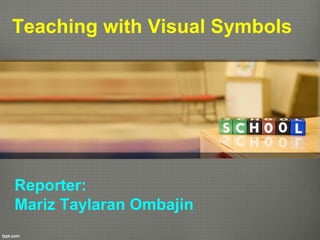Teaching with Visual Symbols
•Download as PPT, PDF•
5 likes•1,244 views
TeaCHING with Visual Symbols
Report
Share
Report
Share

Recommended
Recommended
More Related Content
What's hot
What's hot (20)
Different Diagrams & Charts in Modern Education (Educational Technology)

Different Diagrams & Charts in Modern Education (Educational Technology)
Viewers also liked
Viewers also liked (12)
The evolution and importance of visual communication

The evolution and importance of visual communication
Similar to Teaching with Visual Symbols
Similar to Teaching with Visual Symbols (20)
DIAGRAMMATIC AND GRAPHICAL REPRESENTATION OF DATA (UMAR ABDULLAH).pdf

DIAGRAMMATIC AND GRAPHICAL REPRESENTATION OF DATA (UMAR ABDULLAH).pdf
More from Mariz Ombajin
More from Mariz Ombajin (7)
Organization in the visual arts and Principles of Design

Organization in the visual arts and Principles of Design
Recently uploaded
https://app.box.com/s/x7vf0j7xaxl2hlczxm3ny497y4yto33i80 ĐỀ THI THỬ TUYỂN SINH TIẾNG ANH VÀO 10 SỞ GD – ĐT THÀNH PHỐ HỒ CHÍ MINH NĂ...

80 ĐỀ THI THỬ TUYỂN SINH TIẾNG ANH VÀO 10 SỞ GD – ĐT THÀNH PHỐ HỒ CHÍ MINH NĂ...Nguyen Thanh Tu Collection
Mehran University Newsletter is a Quarterly Publication from Public Relations OfficeMehran University Newsletter Vol-X, Issue-I, 2024

Mehran University Newsletter Vol-X, Issue-I, 2024Mehran University of Engineering & Technology, Jamshoro
Recently uploaded (20)
Basic Civil Engineering first year Notes- Chapter 4 Building.pptx

Basic Civil Engineering first year Notes- Chapter 4 Building.pptx
ICT Role in 21st Century Education & its Challenges.pptx

ICT Role in 21st Century Education & its Challenges.pptx
ICT role in 21st century education and it's challenges.

ICT role in 21st century education and it's challenges.
80 ĐỀ THI THỬ TUYỂN SINH TIẾNG ANH VÀO 10 SỞ GD – ĐT THÀNH PHỐ HỒ CHÍ MINH NĂ...

80 ĐỀ THI THỬ TUYỂN SINH TIẾNG ANH VÀO 10 SỞ GD – ĐT THÀNH PHỐ HỒ CHÍ MINH NĂ...
Kodo Millet PPT made by Ghanshyam bairwa college of Agriculture kumher bhara...

Kodo Millet PPT made by Ghanshyam bairwa college of Agriculture kumher bhara...
This PowerPoint helps students to consider the concept of infinity.

This PowerPoint helps students to consider the concept of infinity.
HMCS Max Bernays Pre-Deployment Brief (May 2024).pptx

HMCS Max Bernays Pre-Deployment Brief (May 2024).pptx
Teaching with Visual Symbols
- 1. Teaching with Visual Symbols Reporter: Mariz Taylaran Ombajin
- 2. Graphs • Graphs present quantitative data for easier analysis and interpretation. It shows comparative relationship of data involved in size, trends and growth. • Graphs are best used in developing and in summarizing a unit.
- 3. Kinds of graphs • Line graph – is the most accurate of all graphs used in plotting trends of relationships between two series of data. It is used when there is a considerable number of data to be plotted and if these data are continuous.
- 7. • Bar graphs – simplest of all graphs to read. They are represented either by vertical or horizontal bars. The lengths of the bars represent an amount or percentage data. It is best when number of values to be compared is small.
- 10. • Circle or pie graph – the sections of which are used to represent component parts of a whole. They always present total amounts, their parts or segments are calculated in percentage or fractional parts of a whole.
- 14. • Pictorial Statistics or pictograph – it makes use of related pictures in showing quantitative data. Pictures give realism and interest so it is widely used specially in the elementary grades.
- 18. • Graphic organizers- (some of which are also called concept maps, entity relationship charts, and mind maps) are a pictorial way of constructing knowledge and organizing information.
- 27. • They help the student convert and compress a lot of seemingly disjointed information into a structured, simple-toread, graphic display. The resulting visual display conveys complex information in a simple-to-understand manner.
- 28. Maps • Maps are usually shown on flat surface and are used to represent the surface of the earth or some parts of it, showing the relative size and position according to scale or projection and position represented.
- 29. Maps according to content • Physical map – also called relief maps, they are the best because of their three dimensional representation; which includes geographical outline of land and water.
- 31. • Commercial or economic maps- also known as product or industrial map since they show land area in relation to the economy.
- 33. • Political map – shows national boundaries down to the smallest division.
- 35. Map language • Scale- shows how much the actual earth’s surface is represented by a given measurement on a map.
- 36. • Symbols- usually a map has a legend that explains what each symbols example highways, railroads, mountains, lakes and plains.
- 37. • Color- the different colors of the map are part of the map language.
- 38. • Geographical grids- this is the entire system of the grid lines. These grid lines are called meridians and parallels. • A meridian is a north to south pole line. • Parallels are lines drawn around the globe with all points along each line with equal distance from the pole.
- 40. • Longitude is a distance in degrees of anplace east or west of the prime meridian. Latitude is the distance in degrees of any place north and south of the equator.
- 43. Understanding Maps, Graps and Charts, What should you do to be successful in reading maps, charts and graphs? The following steps can help:
- 44. • Read the information shown along the side and the bottom of graphs and charts and tables, if any. This will help understand what quantities and qualities are being presented or what comparisons are being made. On maps, notice how the different parts of the map are related to each other. • Determine your purpose for reading the map, chart, table or graph.
